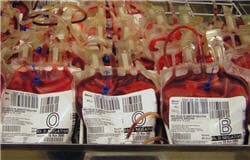Monitoring Blood Safety

One of the most important aspects of blood safety is making sure donated blood does not cause harm. One way CDC plays an important role in keeping the blood supply safe is by assisting state and local health departments and hospitals in investigating reports of potential infectious disease transmission. CDC also monitors the safety of the blood supply by collecting reports of adverse reactions and errors or incidents associated with blood transfusions in the National Healthcare Safety Network (NHSN) Hemovigilance Module. These activities help CDC identify ways to prevent transmission of infectious diseases through blood transfusions as well as other transfusion-related adverse events.
Other federal agencies play important roles in ensuring blood safety. The U.S. Food and Drug Administration (FDA) is responsible for overseeing and regulating the U.S. blood supply. FDA enforces standards for blood collection and distribution of blood products. The agency also inspects blood collection centers and monitors reports of errors, accidents, and adverse events related to blood collection and transfusion. FDA monitors the safety of blood and blood products by requiring reporting of errors and accidents associated with the manufacturing and distribution of blood and blood products. The agency also monitors deaths associated with blood transfusions. Some medical devices used in blood bank collection are also monitored by FDA.
National Surveillance System
The CDC’s Office of Blood, Organ, and Other Tissue Safety conducts surveillance for adverse events following blood transfusions through voluntary reporting by hospital transfusion services. This information is used to prevent blood transfusion-related adverse events through evidence-based interventions and recommendations.
AABB, formerly known as the American Association of Blood Banks, is now only known by its acronym.
In 2010, CDC launched the first national public health surveillance system to monitor adverse events among patients who receive blood transfusions. The Hemovigilance Module was developed in the Biovigilance Component of CDC’s National Healthcare Safety Network (NHSN) with input and support from AABB, representing the transfusion community as a whole. It is designed to capture adverse reactions and process incidents related to blood transfusion. By collecting data in a national system, CDC analyzes aggregate data to better understand how to prevent transfusion-related adverse events. Visit the National Healthcare Safety Network for more information on the Hemovigilance Module and other healthcare safety-related surveillance efforts.
Information for Healthcare Professionals and Policy Makers
In August 2006, the Department of Health and Human Services (HHS) Advisory Committee on Blood and Tissue Safety and Availability (ACBTSA) recommended coordination of Federal actions and programs to support and facilitate biovigilance in the United States in partnership with private sector initiatives. Biovigilance is defined as a national patient safety program to gather, analyze, and report data on outcomes related to the collection and transfusion and/or transplantation of blood components and derivatives, cells, tissues, and organs. This report summarized biovigilance efforts in the United States and recommended a national plan for biovigilance in the future, including improvement of biovigilance system infrastructure and bridging of critical gaps.